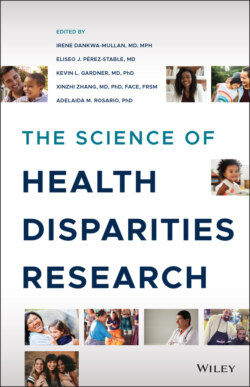Читать книгу The Science of Health Disparities Research - Группа авторов - Страница 52
3.3.3 Race Versus Ethnicity
ОглавлениеCompared to race, which often refers to one's physical characteristics, ethnicity refers to an individual's belonging to a social group that shares a common national or cultural background. The largest minority group in the United States, Latinos, is an ethnic group that combines persons from multiple countries and ethnic identities. Latinos sometimes share a similar history, culture, and religion, but not always. They mainly speak Spanish, but often different dialects. It is also important to note that throughout much of Latin America there are indigenous groups that do not speak Spanish as their primary language.
Health risks can arise due to ethnicity‐specific characteristics regardless of race as well as due to race regardless of ethnicity. For example, consider a Cuban of African descent and an African American who share physical characteristics. This may result in both persons being at increased health risks due, for example, to living in poor‐quality housing. However, they are from different ethnic groups, which may result in different health behaviors and health risk profiles [5]. Thus, while both may be at increased risk of exposure to housing discrimination (due to their race – as measured by skin color), the individual identifying as Cuban may be at an increased risk of encountering barriers to accessing quality healthcare due to his or her status as an immigrant, Spanish being their first language, and/or holding ethnicity‐specific health beliefs.
Consider the experiences of US immigrants from East Asia, Southeast Asia, and the Pacific Islands, who originate from dozens of ethnic groups, some with mixed indigenous or European descent. Upon arrival in the United States, they are viewed as the single racial group of Asian or Pacific Islander. A similar example can be made of immigrants during the nineteenth and twentieth centuries from the European nations of Ireland, Italy, and the former Soviet Union and Russia. Despite coming from distinct cultural backgrounds, they were categorized as White in the United States. Rarely is this source of variation taken into account in health research. The same can be said for indigenous populations in South America and Africa. The Yoruba of Brazil and Nigeria share a common cultural background, yet they differ in nationality. Within the American cultural context, they both would be viewed as the single racial group of Black or African American, thus adopting the health risk profile associated with that group.
We often try to capture the concepts of ethnicity and race in one summary term, though doing so can result in some degree of measurement error. More importantly, the lack of conceptual clarity leaves a great deal of room for erroneous interpretations of research findings and, consequently, for ineffective public policy, public health programming, and even medical practice. OMB Directive No. 15 instructs that, where possible, race and ethnicity be captured by separate questions: the first for the individual's race (American Indian or Alaskan Native, Asian or Pacific Islander, Black or African American, or White), the second for ethnicity (Hispanic or Latino origin or not of Hispanic or Latino origin) [3]. These questions provide the opportunity to identify an individual's self‐reported race and ethnicity.
Notably, some mixed‐race groups, such as Latinos, often don't self‐report race outside their ethnicity. A Cuban of African descent may only view themselves as Hispanic or Latino, and not as an individual of Hispanic or Latino ethnicity and Black or African American race based on their skin color. Due to this issue, “other” is a rapidly growing response to the census race question. The US Census Bureau is now considering changing to a single question to address this issue. However, it is worth pointing out that if this change happens, it will be essentially impossible to conduct intersectional research on groups like Black Latinos [3].
